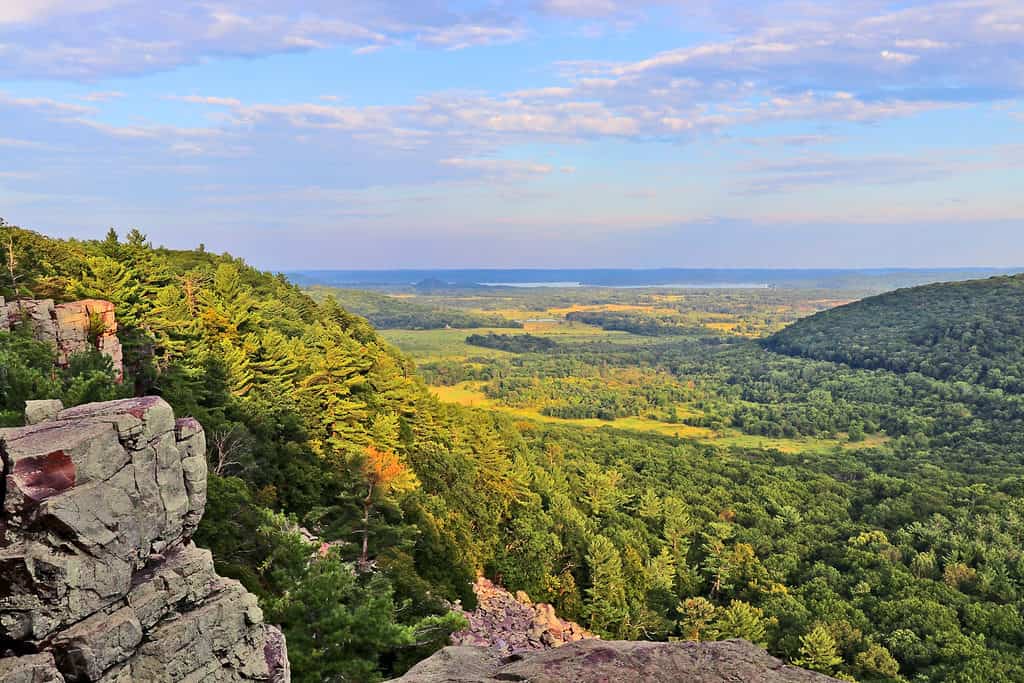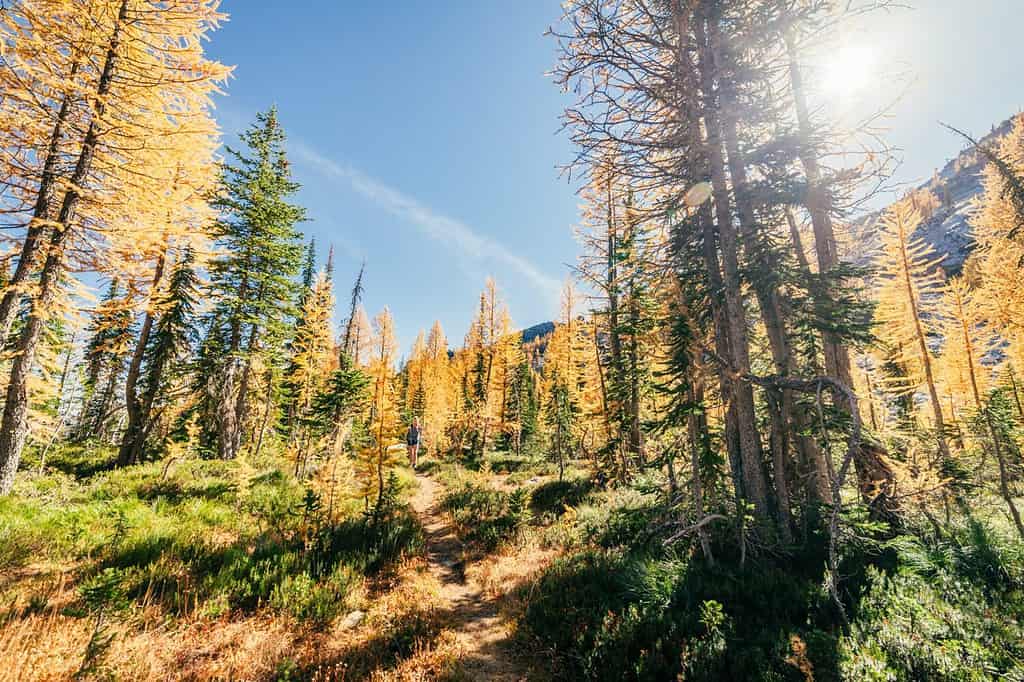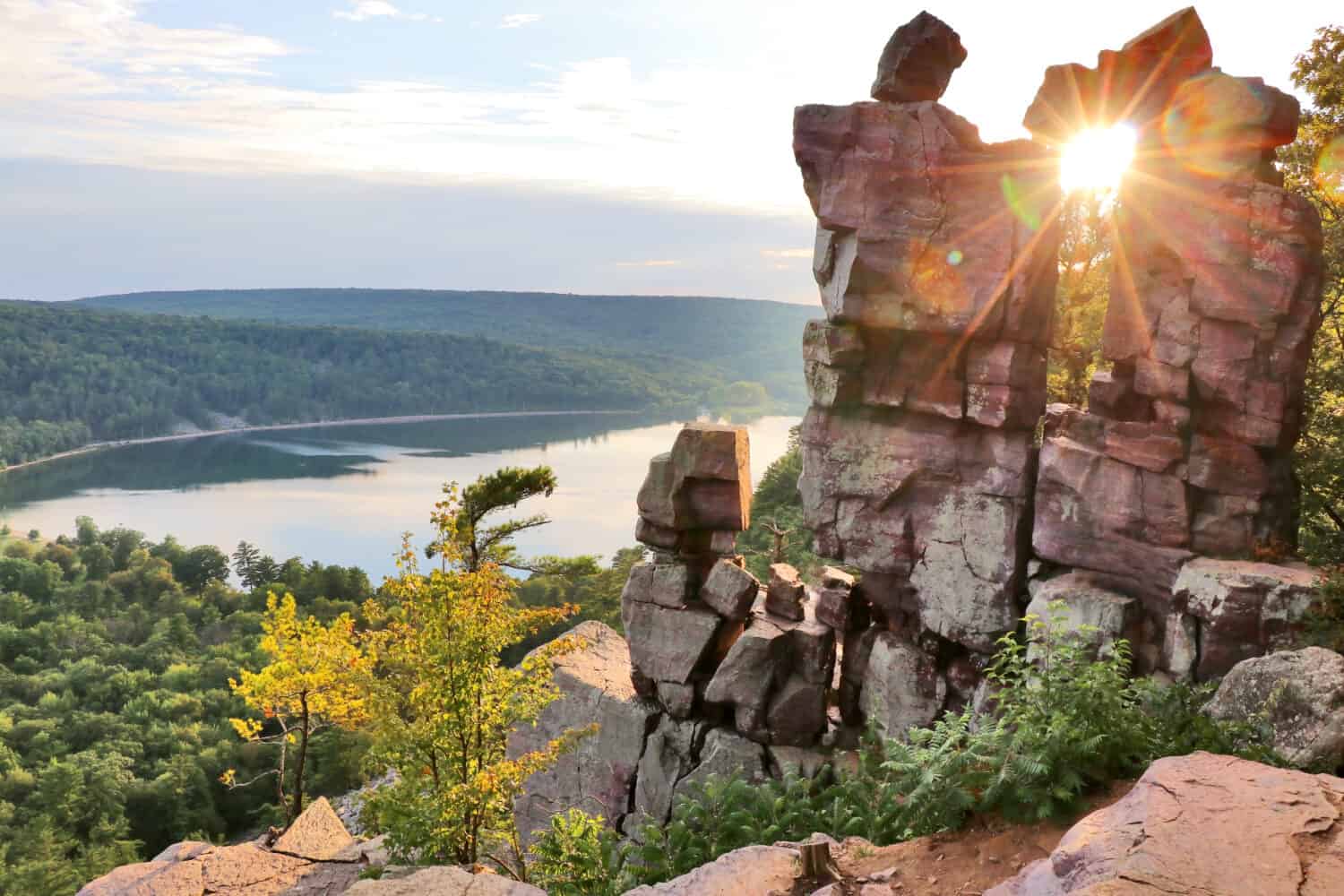Quick Answer:
- Wisconsin’s Ice Age Trail, which covers more than 1,200 miles, takes 2-3 months to hike in its entirety.
For those who love being in the arms of nature and exploring new trails, the Ice Age Trail in Wisconsin offers a unique and challenging experience. This trail is not just a footpath meandering through the wilderness. It is a journey back in time, where you can walk in the footsteps of glaciers from the last Ice Age.
What is the Ice Age Trail?

One section of the Ice Age Trails runs through Devil’s Lake State Park in Wisconsin.
©MarynaG/Shutterstock.com
The Ice Age Trail is one of only eleven National Scenic Trails in the United States. Stretching across the state of Wisconsin, it covers more than 1,200 miles! It runs from Potawatomi State Park in Sturgeon Bay to Interstate State Park on the Minnesota border. The trail follows the edge of a terminal moraine from the last Ice Age, making it a living testament to our planet’s past.
This fascinating trail offers a glimpse into what Wisconsin might have looked like some 12,000 years ago. Try to picture it when mammoths roamed and glaciers dominated the landscape. Along the way, you’ll encounter some of the state’s most stunning natural beauty, including prairies, pinewoods, wetlands, and bluffs.
Ice Age Trail Length and Terrain—1,200 Miles

Ice Age National Scenic Trail is home to American red squirrels, porcupines, white-tailed deer, and red foxes.
©thegreatluna8713/Shutterstock.com
The trail offers a variety of terrains to cater to hikers of all abilities. It is divided into several sections, each with its unique characteristics and challenges. The total trail length is 1,200 miles!
The Eastern section of the Ice Age Trail stretches from Potawatomi State Park to the City of Manitowoc. It offers hikers a predominantly rural and flat experience. This portion of the trail provides an opportunity for walkers to immerse themselves in the peacefulness and tranquility of Wisconsin’s countryside. As hikers traverse through this region, they will be greeted by vast expanses of open fields and picturesque farmland.
Moving westward along the trail, adventurers will encounter a shift in terrain as they enter the central part. This section spans from the City of Manitowoc to the City of Medford. Here, rolling hills dominate the landscape, providing not only a refreshing change in scenery but also an added physical challenge for those seeking a more strenuous hike. These undulating hills create a dynamic hiking experience that tests one’s endurance while offering breathtaking views at every turn.
Continuing further westward on their journey along the Ice Age Trail, hikers will approach its Western section. Here the trail leads from the City of Medford all the way to Interstate State Park. This stretch presents perhaps some of nature’s most formidable obstacles, with rugged hills and rocky outcrops dotting its path. The demanding terrain demands both mental and physical fortitude from explorers who dare to conquer it. However, amidst these challenges lie hidden rewards. Stunning vistas atop lofty peaks and opportunities for thrilling rock scrambles provide a sense of accomplishment like no other.
How Long Does It Take to Hike the Ice Age Trail?
On average, it takes two to three months to hike the entire Ice Age Trail. However, this can vary greatly depending on factors such as your fitness level and hiking experience. Not to mention how much time you spend exploring along the way.
For those who cannot commit to such a long hike, there are plenty of shorter sections. You can complete these hikes in a day or over a weekend. Here are a few of the shorter segments. You can view them all on this interactive map.
- Sturgeon Bay Segment—13.7 Miles
- Parnell Segment—13.9 Miles
- Blue Spring Lake Segment—7.1 Miles
- Devil’s Lake Segment—10.9 Miles
- Hartman Creek Segment—5.6 Miles
- Hemlock Creek Segment—7.0 Miles
Regardless of how you choose to experience the Ice Age Trail, every step offers an opportunity for discovery.
Preparing for the Hike

For our safety, be sure to inform your friends and family of your itinerary when hiking.
©MontanaMountainPhotos/Shutterstock.com
To enjoy the Ice Age Trail safely and comfortably, it is important to prepare adequately. This includes ensuring that you are in good physical condition and equipped with essential gear and supplies.
A moderate level of fitness is sufficient for most sections of the trail. However, some parts require a higher level of fitness due to steep inclines and rough terrain.
Essential gear includes sturdy hiking boots, weather-appropriate clothing, and a backpack with food and water supplies. You will definitely need a first-aid kit and navigation tools such as a map or GPS device. You should have a lighter or matches, even for hikes of only one day. It’s also a good idea to check the weather forecast before setting out and prepare accordingly.
What to Wear

Choose shoes that you can comfortably wear for 10 hours at a time.
©adriaticfoto/Shutterstock.com
When exploring the outdoors, wearing the right gear is crucial. Here are recommendations from folks who have traveled on the Ice Age Trail.
- Wear layers of clothing that are made of synthetic fabric or thin wool.
- Rain gear is also recommended for anything longer than a day hike. Although you may be able to get away with a less expensive poncho for shorter hikes.
- Wear sturdy hiking shoes with good ankle support, as opposed to full hiking boots.
- Additionally, wear long pants when walking through areas with tall grass or other vegetation. They can protect against scrapes and insect bites.
Highlights of the Ice Age Trail

You will see many different types of terrain on the Ice Age Trail.
©MarynaG/Shutterstock.com
The Ice Age Trail, spanning over 1,000 miles across Wisconsin, is a captivating journey that promises an array of remarkable points of interest. Nature enthusiasts and adventure seekers alike will find themselves immersed in the diverse geological formations that dot the trail’s landscape.
One such marvel is Devil’s Lake State Park. It boasts awe-inspiring quartzite cliffs that stand as towering sentinels against the backdrop of vibrant foliage. The sheer grandeur of these cliffs commands attention and offers hikers a glimpse into the ancient forces that shaped this region during the Ice Age.
Moving forward along the trail, travelers will stumble upon Horicon Marsh. This picturesque oasis is brimming with natural beauty. As hikers traverse its winding paths, they will be greeted by vast expanses of cattail marshland stretching as far as the eye can see. This mesmerizing wetland is a haven for countless species of flora and fauna. It also holds the title of being America’s largest freshwater cattail marsh.
Continuing on their expedition, adventurers will ascend to new heights when they reach Holy Hill. This is an ethereal basilica nestled atop a majestic Kame formation. From this elevated vantage point, panoramic vistas unfold before visitors’ eyes, revealing breathtaking views encompassing rolling hills and lush forests below. It is here where one can truly appreciate nature’s artistry at its finest.
Wildlife on the Ice Age Trail

If you are quiet while hiking, you may just spot a red fox.
©Ondrej Prosicky/Shutterstock.com
The Ice Age Trail offers a remarkable opportunity to encounter a diverse range of wildlife species as hikers venture through its scenic path. Among the many fascinating mammals that you can see along this trail are the elusive red fox, the agile American red squirrel, and the graceful white-tailed deer. If you are lucky enough, you may catch sight of porcupines, black bears, and even majestic grey wolves. Hikers have reported many such sightings.
In addition to these captivating mammalian inhabitants, the avian world also thrives within different sections of the Ice Age Trail. As adventurers journey through its southern stretches, they may come across unique bird species. Here you will see the melodious Acadian flycatcher or perhaps catch sight of Henslow’s sparrow gracefully darting through the foliage. The vibrant presence of red-headed woodpeckers or elusive hooded warblers adds an enchanting touch to this part of the trail.
As one ventures further north along this expansive pathway, a new ensemble of feathered creatures takes center stage. Here is where nature enthusiasts will often find themselves serenaded by distinctive melodies from white-throated sparrows perched on tree branches. You may be captivated by encounters with ruffed grouse displaying their impressive courtship rituals amidst lush surroundings. It is not uncommon for hikers in these northern regions to witness awe-inspiring bald eagles soaring majestically overhead.
Safety on the Ice Age Trail
Safety should always be your top priority when hiking. Always let someone know your hiking plans before you set out. Leave your itinerary with friends or family members and stay true to your timetable. Check in often so they know that you are safe.
Carry a cell phone for emergency calls. Though be aware that reception may be spotty in some areas. And familiarize yourself with basic first-aid procedures.
Do not camp near road crossings. It is best to stay at least half a mile away from the road.
Ensure you stay hydrated and protect yourself from ticks by wearing long pants and using insect repellent. You must always stay on marked trails to avoid getting lost or damaging delicate ecosystems.
Conclusion
Whether you’re a seasoned hiker seeking your next challenge or simply someone who loves spending time outdoors amidst natural beauty, Wisconsin’s Ice Age Trail awaits. Its rich glacial history and diverse terrain make it an unforgettable journey through time.
So step into your hiking boots, pack your backpack, and immerse yourself in this unique outdoor adventure. Not only will you deepen your understanding of our planet’s history, but you’ll also have countless stories to tell about your time walking in the footsteps of glaciers.
The photo featured at the top of this post is © MarynaG/Shutterstock.com
Thank you for reading! Have some feedback for us? Contact the AZ Animals editorial team.







